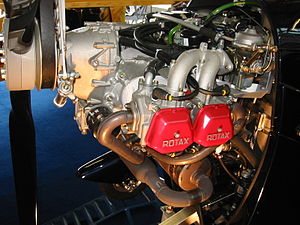
The Rotax 912 is a horizontally-opposed four-cylinder, naturally-aspirated, four-stroke aircraft engine with a reduction gearbox. It features liquid-cooled cylinder heads and air-cooled cylinders. Originally equipped with carburetors, later versions are fuel injected. Dominating the market for small aircraft and kitplanes, Rotax produced its 50,000th 912-series engine in 2014. Originally available only for light sport aircraft, ultralight aircraft, autogyros and drones, the 912-series engine was approved for certified aircraft in 1995.

The Rotax 582 is a 48 kW (64 hp) two-stroke, two-cylinder, rotary intake valve, oil-in-fuel or oil injection pump, liquid-cooled, gear reduction-drive aircraft engine manufactured by BRP-Rotax GmbH & Co. KG. It is for use in non-certified aircraft operating in day visual flight rules.
The Rotax 377 is a 35 hp (26 kW), twin-cylinder, two-stroke aircraft engine, that was built by BRP-Rotax GmbH & Co. KG of Austria for use in ultralight aircraft.
The Rotax 532 is a 48 kW (64 hp) two-stroke, two-cylinder, rotary valve engine, liquid-cooled, gear reduction-drive engine that was formerly manufactured by BRP-Rotax GmbH & Co. KG. It was designed for use on ultralight aircraft.
The Rotax 618 is a 73.8 hp (55 kW) two-stroke, two-cylinder, liquid cooled, gear reduction-drive engine that was formerly manufactured by BRP-Rotax GmbH & Co. KG. It was designed for use on ultralight aircraft.
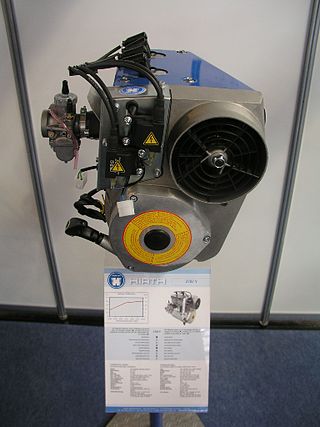
The Hirth 2702 and 2703 are a family of in-line twin cylinder, two stroke, carburetted aircraft engines designed for use on ultralight aircraft and especially two seat ultralight trainers, single seat gyrocopters, and small homebuilts. It is manufactured by Hirth of Germany.
The Hirth 2704 and 2706 are a family of in-line twin cylinder, two stroke, carburetted aircraft engines, with optional fuel injection, designed for use on ultralight aircraft and especially two seat ultralight trainers, single seat gyrocopters and small homebuilts. It was manufactured by Hirth of Germany.
The Hirth F-30 is a horizontally opposed four-cylinder, two-stroke, carburetted aircraft engine, with optional fuel injection, designed for use on ultralight aircraft and homebuilts. It is manufactured by Hirth of Germany.
The Hirth 3202 and 3203 are a family of in-line twin cylinder, two stroke, carburetted aircraft engines, with optional fuel injection, designed for use on ultralight aircraft, especially two seat ultralight trainers, gyrocopters and small homebuilts. It is manufactured by Hirth of Germany.
The Hirth 3502 and 3503 are a family of liquid-cooled, in-line twin-cylinder, two-stroke, carbureted aircraft engines, with optional fuel injection, designed for use on ultralight aircraft and small homebuilts. It is manufactured by Hirth of Germany.
The Zenoah G-50 is a twin-cylinder, horizontally opposed, two stroke, carburetted aircraft engine, designed for use on ultralight aircraft.

The HKS 700E is a twin-cylinder, horizontally opposed, four stroke, carburetted aircraft engine, designed for use on ultralight aircraft, powered parachutes and ultralight trikes. The engine is manufactured by HKS, a Japanese company noted for its automotive racing engines.
The Arrow 500 is a twin-cylinder, horizontally opposed, two-stroke, single or dual ignition, aircraft engine that was designed for ultralight aircraft by Arrow SNC of Italy.
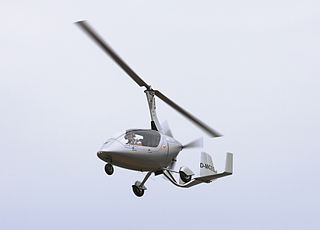
The RotorSport Calidus is a German tandem two-seater autogyro modified in the UK to meet British Civil Airworthiness Requirements CAP643 Section T. The Calidus is an enclosed-cockpit development of the open-cockpit RotorSport UK MT-03. New-build AutoGyro Calidus aircraft are imported from the manufacturers, AutoGyro GmbH in Hildeshem, Germany and completed to British regulations by RotorSport UK Ltd.

The AutoGyro Calidus is a German autogyro, designed and produced by AutoGyro GmbH of Hildesheim. The aircraft is supplied as a complete ready-to-fly-aircraft.
The Celier Kiss is a series of Polish autogyros that was designed by Frenchman Raphael Celier and produced by his company, Celier Aviation of Jaktorów-Kolonia, Poland. When it was available the aircraft was supplied as a kit for amateur construction or as a complete ready-to-fly-aircraft.
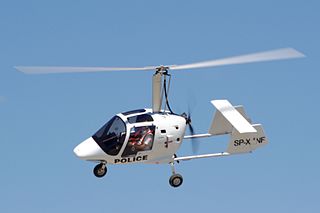
The Celier Xenon 2 is a series of Polish autogyros that was designed by Frenchman Raphael Celier and produced by his company, Celier Aviation of Piotrków Trybunalski, Poland. The aircraft is supplied as a kit for amateur construction or as a complete ready-to-fly-aircraft.
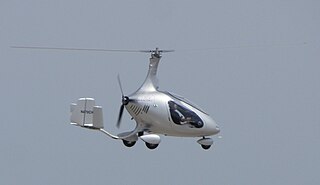
The Autogyro Cavalon is a German autogyro, designed and produced by AutoGyro GmbH of Hildesheim. It was introduced at the 2011 Aero show in Friedrichshafen. The aircraft is supplied as a complete ready-to-fly-aircraft.

The AutoGyro MT-03 is a German autogyro, designed and produced by AutoGyro GmbH of Hildesheim. The aircraft is supplied as a complete ready-to-fly-aircraft.
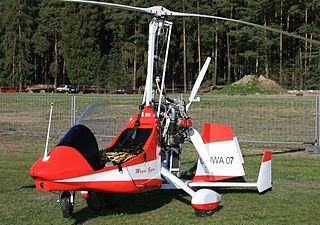
The Magni M-14 Scout is an Italian autogyro, designed and produced by Magni Gyro srl of Besnate. The aircraft is supplied as a complete ready-to-fly-aircraft.
